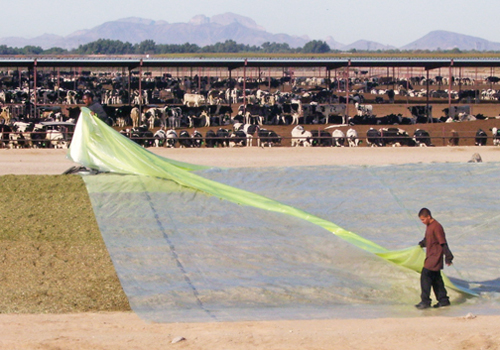With half of the country now in a drought disaster area, if there was ever a year for dairy farmers to take reducing silage losses seriously, this is it.
The most silage you have is when it is standing in the field; the least you have is when it is being eaten. In between are a depressing number of "where did it go?" events that result in less feed being in the bunk than you expected. In a year like this where feed supplies may wind up being critically short and prices could wind up being unbelievably high, minimizing as many of them as possible could easily save a dairy farmer tens of thousands of dollars.
According to Keith Bolsen, professor emeritus at Kansas State University, about 20 percent of corn silage is lost to shrinkage each year. What's startling is, he emphasizes that single-digit shrinkage is readily doable if the dairy's silage team makes a commitment to build and pack piles properly, cover and seal them thoroughly, and use proper feed-out face management.
He says the easiest way to cut 3 to 5 percent from shrinkage losses is to use enough tractors to pack piles properly. Corn silage should be packed to a density of 15 to 16 pounds of dry matter per cubic foot and 44 to 48 pounds of fresh weight per cubic foot. However, he often sees packing densities in the mid-30s or less.

He and other forage specialists are proponents of inoculants, oxygen barrier film covers (pictured here) and face management practices that reduce exposure to air. This last item is a favorite of Bolsen's – and another area where the difference between sloppy and smooth and only removing what needs to be fed, can cut silage shrinkage by another 2 to 4 percent.
The most silage you have is when it is standing in the field; the least you have is when it is being eaten. In between are a depressing number of "where did it go?" events that result in less feed being in the bunk than you expected. In a year like this where feed supplies may wind up being critically short and prices could wind up being unbelievably high, minimizing as many of them as possible could easily save a dairy farmer tens of thousands of dollars.
According to Keith Bolsen, professor emeritus at Kansas State University, about 20 percent of corn silage is lost to shrinkage each year. What's startling is, he emphasizes that single-digit shrinkage is readily doable if the dairy's silage team makes a commitment to build and pack piles properly, cover and seal them thoroughly, and use proper feed-out face management.
He says the easiest way to cut 3 to 5 percent from shrinkage losses is to use enough tractors to pack piles properly. Corn silage should be packed to a density of 15 to 16 pounds of dry matter per cubic foot and 44 to 48 pounds of fresh weight per cubic foot. However, he often sees packing densities in the mid-30s or less.

He and other forage specialists are proponents of inoculants, oxygen barrier film covers (pictured here) and face management practices that reduce exposure to air. This last item is a favorite of Bolsen's – and another area where the difference between sloppy and smooth and only removing what needs to be fed, can cut silage shrinkage by another 2 to 4 percent.







